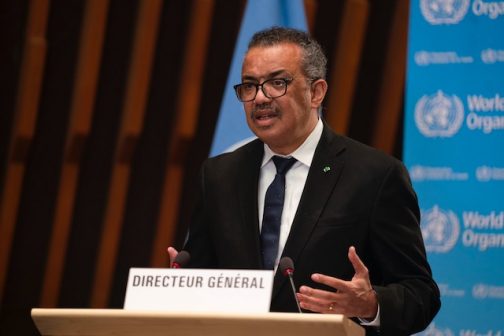15th February, 2021

By Cecilia Ologunagba
The World Health Organisation (WHO), on Monday, released a set of tools to help countries improve the diagnosis and treatment of cancer among children.
WHO said this in a statement issued from its headquarters in Geneva to mark the International Childhood Cancer Day (ICCD), globally marked on Feb. 15.
ICCD is a global collaborative campaign to raise awareness about childhood cancer and to express support for children and adolescents with cancer, the survivors and their families.
The statement said the package includes a “how-to” guide for policy-makers, cancer control programme managers and hospital managers, an assessment tool to inform implementation, and a multilingual online portal for information-sharing.
The new tools will support countries with the implementation of the CureAll approach, adopted by WHO’s Global Initiative for Childhood Cancer.
The Initiative, inaugurated in 2018, aims to achieve at least 60 per cent survival for childhood cancer globally by 2030.
Currently, children living in high-income countries have an 80 per cent chance of cure, while less than 30 per cent of children diagnosed with cancer in many low- and middle-income countries (LMICs) survive.
During the last two years, the Global Initiative, supported by St. Jude Children’s Research Hospital, a WHO Collaborating Centre in the United States of America, has become active in more than 30 countries and benefits from the participation of more than 120 global partners.
These partners work together to support governments with the implementation of the CureAll approach, addressing common reasons for the low survival of children with cancer in LMICs.
These reasons include late or incorrect diagnosis, insufficient diagnostic capacity, delays in or inaccessible treatment and treatment abandonment.
The UN health agency, however, said that solutions to all of these issues were provided in the new “how-to” guide, which is based on four pillars.
“Centres of excellence with defined referral pathways and a trained workforce, inclusion of childhood cancer in national benefit packages for universal health coverage.
“Also, treatment standards based on evidence and tailored to local capacity, and robust information systems for continuous monitoring of programme performance.
“Case studies from countries which have begun implementing the CureAll approach such as Ghana, Peru and Uzbekistan, are also included.’’
In addition, it said that the onset of the COVID-19 pandemic in early 2020 created a need for another type of data on the effect of COVID-19 on children with cancer.
“In response, St. Jude Children’s Research Hospital began collecting, in collaboration with partners, data on COVID-19 infection among children with cancer.
“As of early February, more than 1,500 childhood cancer patients from 48 countries had tested posted for COVID-19.
“Data available appears to indicate that the effect of COVID-19 on children with cancer is less severe than feared, although there remains a concern about the effect of the pandemic on willingness to seek care and complete therapy.
“This will have consequences for children with cancer in the longer term and may lead to worsened outcomes.’’
The statement quoted Dr Bente Mikkelsen, Director of WHO’s Department of Non-Communicable Diseases, as saying “Providing childhood cancer care and implementing the Global Initiative remain priorities.
“It remains priorities during the COVID-19 pandemic and will continue to be priorities when it ends.
“Each year, an estimated 400, 000 children are diagnosed with cancer globally, and the vast majority of these children live in low- and middle-income countries where the likelihood of survival is much lower.
“We can – and must – give these children a better chance at life.”
NAN



